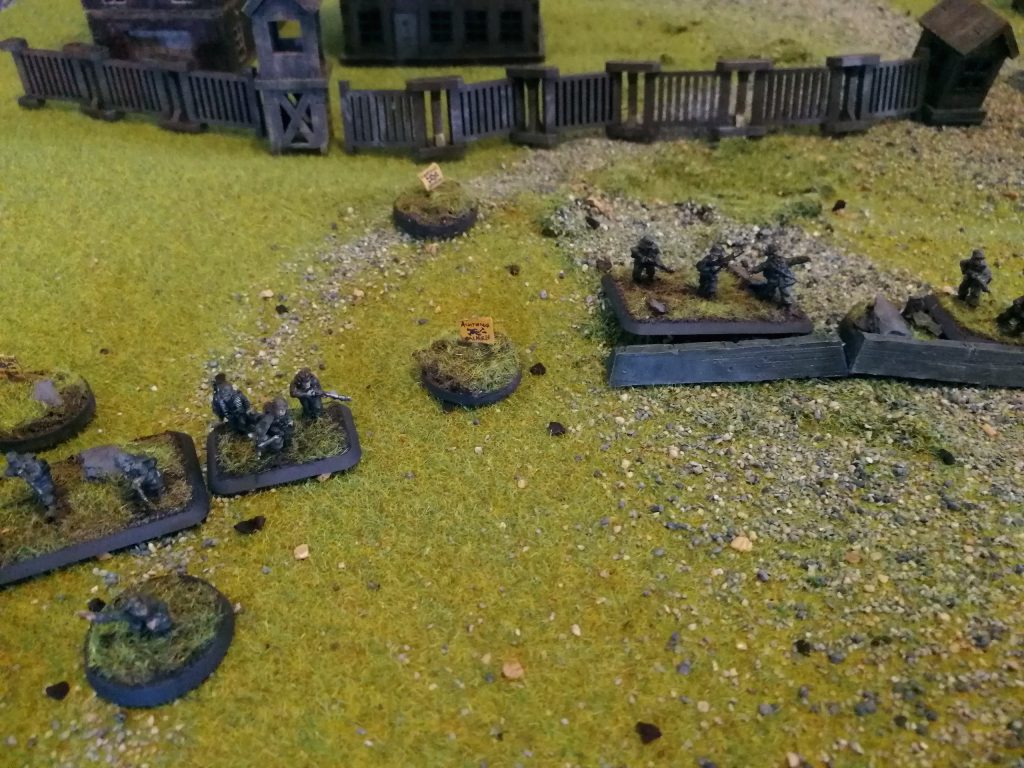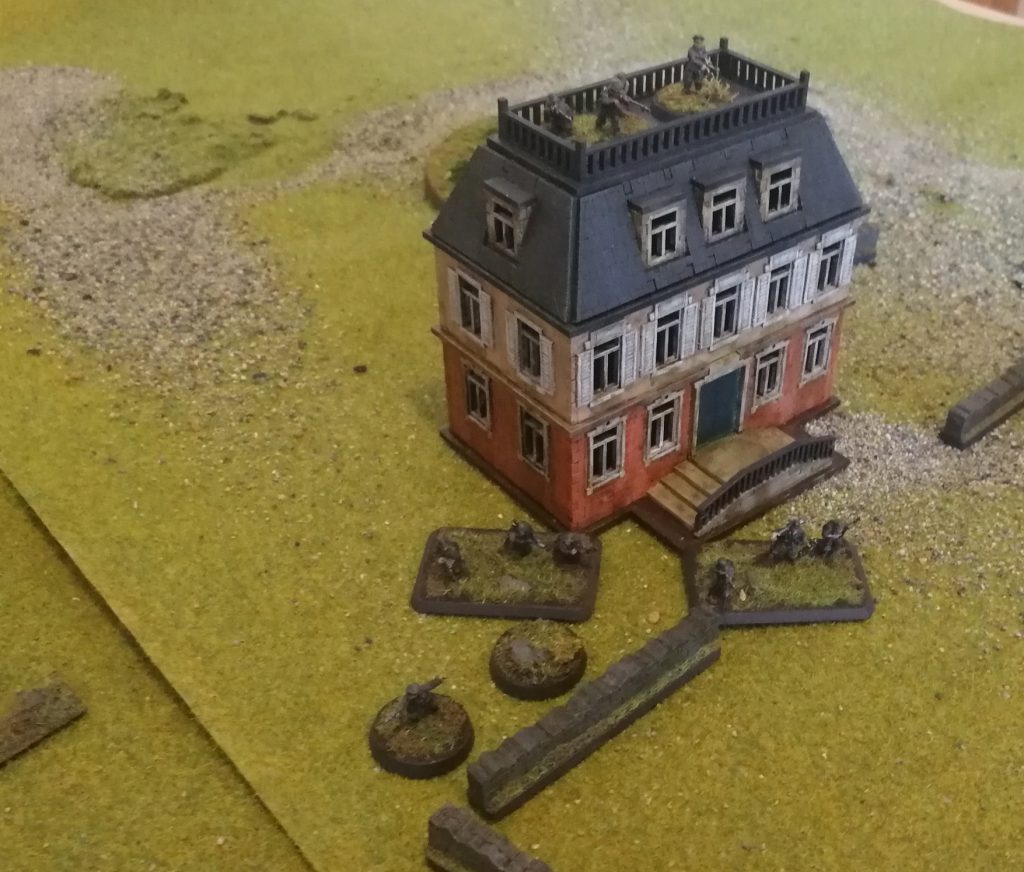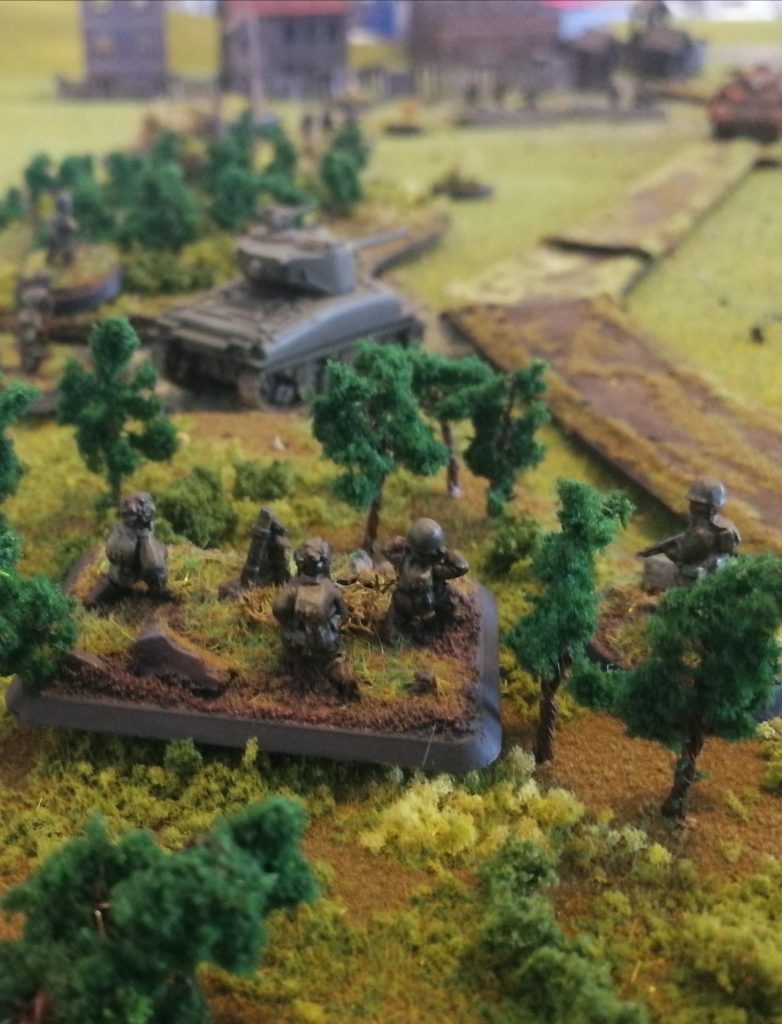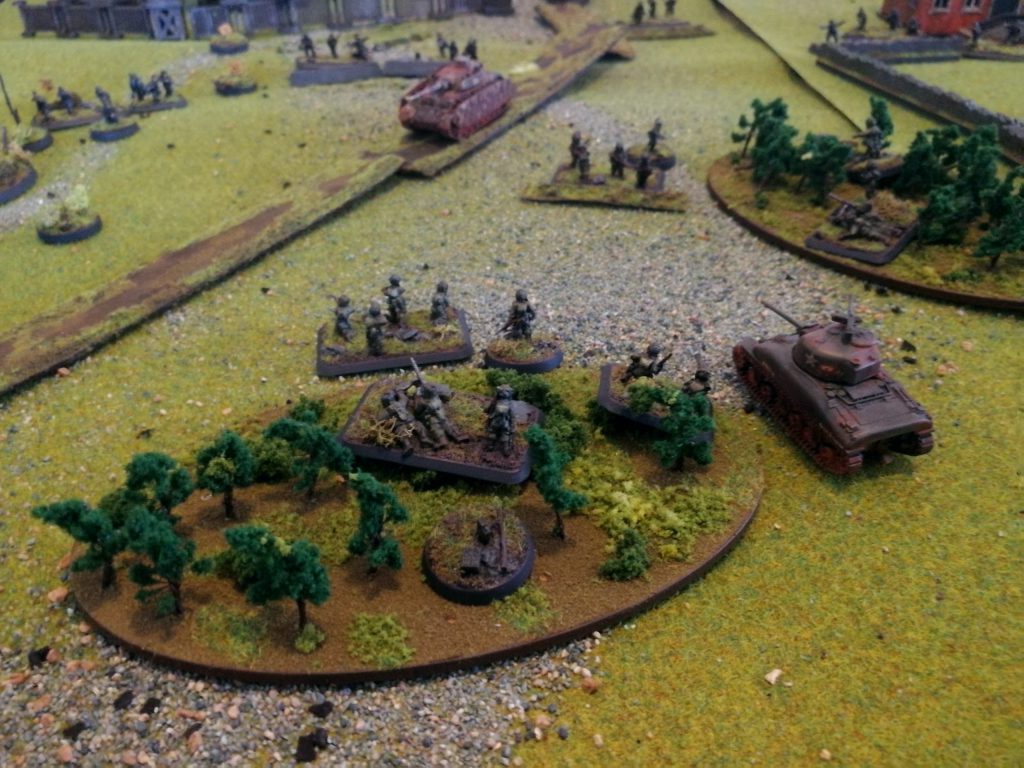Once more into the breach we go today, to fill it up with our glorious World War 2 narrative gaming experiences. We’re taking a look at Chain of Command, a historical wargame developed and published by Too Fat Lardies.
The games that Too Fat Lardies write are all about flavour, and when they take a theme they drive everything they write to the service of that theme. For Chain of Command, it’s about the leaders who directed the soldiers under their command, and whose brilliance (or ineptitude) was the thing upon which victory or defeat rested. Leadership, command and the chain of command is really what this game is about in a way other games tend to gloss over. It’s about the confusion, frustration, and exaltation of not having complete control over a situation, but prevailing nonetheless (sometimes). One of the ways it does this is to put Force Morale at the front and centre – the game is won by collapsing the morale of your opponent’s force.
The game focuses on platoon-level actions, with about 30 soldiers in play at any one time. You may also end up with a small number of support options; tanks, heavy weapon teams or fortifications can round out your force. The game is flexible in terms of scale, but the Lardies tend to play at 28mm, and so many of the examples are written with that in mind. I play almost exclusively in 15mm (though have played at 28mm) and hot damn is it cheap to play at 15mm.
Let’s just pick out some key reasons why Chain of Command is, in my eyes, one of if not the best wargames in existence.
Command dice
Chain of Command is played over a series of turns broken down into a number of phases, which probably sounds familiar. But this works in a slightly different way to what you might expect: each phase is actually more like a turn in 40k, with a player doing all kinds of actions with a number of units. What kind of actions and how many units depends on your command dice.
Your command dice number 4-6, depending on the quality of your soldiers. You roll them at the start of each phase. Each result lets you do something different: activating a unit, a team in a unit, a leader who can command units for you, or generating Chain of Command dice. Why these weren’t called command I don’t know, but you can’t have everything I guess.
You can spend those Chain of Command dice on extra effects, like activating out of turn, ambushing, auto-passing morale… A bit like stratagems. They’ve got another important use too: ending the turn. At the turn end, broken units run away, smoke clears away, markers get taken off and you do some housekeeping. Then you start a new turn with phases.

The last result on a command die is a phase sequence result on a 6. Depending on how many 6s you roll, the structure of the phase can change dramatically, simulating the chaotic back and forth of real combat.
Roll zero or one 6s on your dice and the next phase is your opponent’s. Roll two, and you get to go again. Three, and this is the last phase of the turn. Your opponent gets the first phase in the next turn.
Four or more and things get intense. This is the last phase of the turn, but you get the first phase of the next turn. You also get a Chain of Command die (not a command die, a Chain of Command die, and enormous benefit) and a random event happens. Almost every time this happens in a game the entire scenario shifts wildly. In one recent game with fellow Goonhammer author Pvt_Snafu a large barn caught fire in the middle of the table creating an enormous cloud of smoke that blocked line of sight for half my army. It was a turning point, and became the focus of lots of extremely cool manoeuvring and tactics.
The upshot of all of this is you’ll always get to do stuff that’s useful when you get to activate your troops, but it’s rarely exactly what you want and you can never 100% predict when you’ll get to act again, or when the turn will end and the situation will change. Or when a building will catch fire unexpectedly. It’s a great system for representing the chaos of war, while not making it feel miserable or unreasonable. That’s a really hard thing to represent in a game, and Chain of Command does it very convincingly.
Snipers
This rule makes it in because it’s so fucking cool, but it is admittedly a tiny tiny part of the game.
Snipers don’t work like other units. They’re a team represented as a single base with a sniper and spotter. You deploy them and if you activate them to move just pick them up and put them anywhere within 18″. When they shoot they can hit anything on the table they have line of sight to. If they hit, they inflict shock on the unit disproportionately, and are way more likely to kill a leader. They can snipe vehicle crew too.

This is where it gets cool. Units can’t shoot snipers normally. Instead, they have to be on overwatch covering the arc the sniper is in. When shot by a sniper, they roll and on a 6 they locate the sniper. Each time the sniper shoots them that roll gets easier. Once they’ve spotted the sniper, that unit and that unit only can shoot at them. Until the sniper relocates. If a unit manages to get in base to base with a sniper the sniper is just removed.
What does this mean? Well on an urban table, that sniper in the high window will take out your lieutenant, then you scream SNIPER and run for cover. You all stay on overwatch staring at the sniper until another shot rings out. And another and there! The glint of the scope! The squad opens fire… Did they hit him? They advance cautiously, and all goes well… until their sergeant goes down with a shot from a building three down. The bastard relocated.
Honest to God every game should use these rules for snipers.
Force organisation and reinforcements
This is one of the parts of the game that often catches new players off guard, because it feels so alien to most wargaming experiences. But once you get used to it, the force organisation mechanics used are the best balance of historical realism and flexibility I’ve ever seen in a game.
The only twist is you’re not always 100% what is going to be in your army before you turn up to play.

When you’re choosing what to play in Chain of Command, you pick the nation of the force and then you pick one of the platoons listed. These are pretty strictly historical representations, with the number and composition of units as close as possible to what was actually fielded. So a regular German infantry platoon has three squads of ten men, each with an Obergefreiter and split into an LMG team and a rifle team. They’re led by a Leutnant who also directs a panzerschreck team.
So far so good. But what happens if your opponent brings a super-elite platoon like a British Airborne platoon, or a much less powerful one like a Soviet conscript platoon? Well, that’s where support comes in. Every platoon has a force rating, ranging from 10 down to -10. This is a representation of how powerful it is.
Each scenario you play tells you at some point how many levels of support you have. This usually involves a dice roll, and can vary a lot depending on the scenario – asymmetric scenarios in particular might give one side considerably more. But now we bring those ratings into play. Compare the ratings of the platoon, and the person with the lower rating gets a number of bonus levels of support equal to the difference.
Once you know the amount you have to play with you can spend those levels on the support list for your nations, letting you bring additional units, tanks, more officers, have pregame barrages, and so on. There are other more niche effects too, including giving you medics, barbed wire, even placing minefields on the board. The more powerful the support choice, the more levels it’s worth.
Taking our example above, the German platoon (rating 0) faces down a British Airborne platoon (rating +7). That means-before any dice are rolled-the Germans could bring a Panzer IV with them. The British will get some support choices too, because they generate some from the scenario, but the Germans have way more.
Practically speaking, you can bring a selection of stuff you think is cool or could be useful, and pick from it depending on what your opponent brings and what scenario you play. It means you’ll have that historical core but also a lot of interesting additions. Alternatively agree in advance with your opponent what scenario to play and work out the levels of support you’ll get to bring, and prepare what you want in advance.
Shock and morale
When a unit is fired upon—regardless of if anyone is killed—that unit is likely to suffer shock. Shock is a measure of friction. Due mostly to fear, confusion, and dislocation, doing things on the battlefield is hard. Units can also suffer shock for disordered and rapid movement, as they lose track of positions and are fatigued.
Shock makes it harder for units to move, reducing their speed. It makes it harder for them to effectively fire, reducing the amount of damage they can do. If shock equals or exceeds the number of soldiers remaining, the unit is pinned, and goes to ground, struggling to fight effectively. If shock is double the number of soldiers left or more, the unit breaks: retreating or, if surrounded, surrendering. Leaders can rally units suffering from shock, leading them back to the fight. This is one of the reasons leaders are so essential. Vehicles suffer shock in a similar way, but it’s harder to put on them, and tracked against their commander’s quality instead of numbers.
It’s a pretty decent morale system, right, but nothing revolutionary. Except that’s not the morale system.
Force morale is determined at the start of a game, and is a factor of the quality of an army, and it’s probably the most important thing in the game. In Chain of Command, you don’t win by killing the enemy, but by destroying their force morale and forcing them to retreat or surrender. As units break, rout off the table or are killed, Bad Things Happen. You roll a dice and depending on what it is you might lose no morale, or up to three points.
The tracker only goes up to 11.
If your leaders are caught up in a rout, or killed, then the consequences can be devastating, as the chain of command breaks down and your force morale plummets. As it does, it becomes harder to command your troops, losing command dice from your pool, and struggling to reposition due to the loss of jumping off points (we’ll get onto those next). When it hits zero, the army routs and your opponent can claim victory.
The reason this is brilliant is because it makes exactly the right stuff terrifying. Often things like flamethrowers feel underwhelming in wargames; in this they feel like absolute terror, and God help you if you’re caught in a building when one is fired at you. The shock cascades up, units break, leaders rout, the army’s morale fails.
What about snipers? Those sneaky relocating snipers head-shotting your leaders don’t just hurt that unit or that leader, it causes chaos across your forces. That’s why the best remedy to snipers in a building is the judicious application of flamethrowers.
The patrol phase
Hopefully some of this has caught your imagination but I’m saving what I think is the best for last. Chain of Command is very focused on evoking real history, and in real history platoons rarely lined up neatly a couple of hundred yards away until someone blew a whistle (wrong war for that).
The game solves this problem by not having anything start on the table, and deciding how that first clash of the two forces occurs with something called the patrol phase. This takes place before the first turn, and represents scouts and spotters from each force encountering each other, getting a lay of the land, and identifying cover for troops to move up to engage from.
In the patrol phase each of you take a number of patrol markers (2.5″ tokens marked as your army, but classy players base scout miniatures on them) and put them in starting positions. How many you get and where they start depends on the scenario, but usually it’s 3 or 4 and they start on your table edge.
Now whoever has the higher force morale starts by moving one marker up to 12″, making sure it doesn’t end more than 12″ from at least one other marker of theirs. You take it in turn to move, creating a wiggly line of your patrol’s progress into no man’s land. As soon as a marker gets within 12″ of an enemy one, it stops dead, even if it’s not moved the full 12″. Once all the markers have stopped dead, it’s time to place jumping off points.

For each patrol marker, draw two imaginary lines from the two nearest enemy patrol markers that intersect on your marker, creating a cone shaped area behind it going back to your board edge. Pick a piece of cover at least 6″ back from your marker in that area, and place a jumping off marker in or behind that cover. If there is no cover, it goes on the board edge.
When they’re all on the board, you’re reading to start playing. When a unit is activated for the first time, it can deploy from a jumping off point, representing the troops moving up to cover and then acting from there.
It’s honestly the best deployment system I’ve ever played. It turns deployment into a fascinating, tactical exercise, that lets you craft your assaults and makes even the same battlefield a new challenge with just a few tweaks of where cover goes. It’s a great example of the care, creativity and attention to historical flavour that is gamified excitingly throughout the whole ruleset.
Getting started
If you’re sold on Chain of Command and want to get stuck in, there are a bunch of different ways to play. At minimum though, you’ll need:
- the rules
- some six-sided dice of three different types you can easily distinguish between
- a bunch of counters to mark overwatch, shock, and so on
- Patrol markers and jumping off points
- A playspace. Six foot by four is recommended, but experience tells me you can get away with four by four, especially at 15mm
- Terrain. You really do want a bunch of buildings or other line of sight blockers, as well as barriers, rough ground and so on. Unlike in many games, there’s not really such a thing as too much terrain in Chain of Command. The more the better
- Miniatures for your forces and support options
Probably if you’re a reader at Goonhammer you have a board of some kind to play on. I’ll assume you can rustle up some poker chips or bases or whatever for counters and markers, and if you’re not swimming in d6 we probably don’t know each other socially.
That leaves miniatures and rules. So what should you go for? Honestly, the possibilities are pretty much endless, but here are three getting started packs at three different price points.
Budget starter (£50/$75 for two players)
- Chain of Command Rulebook in PDF (£19.20, or about 25 freedombux at time of writing)
- Flames of War: Hit the Beach from Battlefront (about £30 from retailers in in the UK, $50 from Battlefront’s online store)
It kind of blows my mind how cheap this is as a way to get started. I couldn’t resist picking this up. The 15mm minis from Hit the Beach are great, and come with little individual bases designed to slot onto the larger group bases. You can either base the little bases onto 20mm rounds or the like, or you can just use the group bases (I was lazy and just used the group bases).
You’ll get huge numbers of extra tanks in particular, and Big Chain of Command, a multiplayer variant, allows for tank squadrons to be played, and you’re ready to go with this lot.

Here are your standard platoons and reserve options I would break out of this set:
US Paratrooper Platoon (Elite)
- Platoon Headquarters: Lieutenant with carbine, Sergeant with SMG, Bazooka Team
- Squad One: Sergeant with SMG, LMG Team and three crew, 8 paratroopers with rifles
- Squad Two: Sergeant with SMG, LMG Team and three crew, 8 paratroopers with rifles
- Support: 60mm Mortar with 5 crew
Suggested Support Choices: M4 Sherman with Junior Leader. Swap it out for a M4 Sherman 76mm if you get a little more support, or throw in an extra bazooka, some cheap reinforcements like barbed wire and barrages, or use a few riflemen as a sniper team.
German Panzergrenadier Platoon (Elite)
- Platoon Headquarters: Leutnant with machine pistol, Panzerschreck Team
- Squad One: Obergefreiter with machine pistol, two panzerfausts, LMG Team with two crew and three riflemen, and an LMG Team with two crew and two riflemen
- Squad Two: Obergefreiter with machine pistol, two panzerfausts, LMG Team with two crew and three riflemen, and an LMG Team with two crew and two riflemen
- Squad Three: Obergefreiter with machine pistol, two panzerfausts, LMG Team with two crew and three riflemen, and an LMG Team with two crew and two riflemen
Suggested Support Choices: Unless you’re playing an asymmetric scenario or you are exceptionally lucky you won’t get to bring a tank or an anti-tank gun as you have way more soldiers than the Americans. So time to load up on panzerschrecks and more infantry, which you have plenty of in the box.
Mid-priced starter (£125/$160 for two players)
- Chain of Command Rulebook in PDF (£19.20/$25)
- German Infantry (Winter) from Warlord Games (£27/$35)
- German Winter Panzerschrek, Flamethrower and Sniper Teams from Warlord Games (£12/$15)
- German Winter HQ from Warlord Games (£8/$10)
- Soviet Infantry (Winter) from Warlord Games (£31/$40)
- Soviet Maxim MMG Team (Winter) from Warlord Games (£8/$10)
- T34/76 Medium Tank from Warlord Games (£20/$25)
This is a solid start for either a German or Soviet army fighting on the Eastern front from the middle of the war onwards, outfitted for winter. This is a really cool thematic army set, and it’s still affordable (by 40k standards anyway) to grab both armies together.
You’ll get a more limited selection than in the budget starter, but this is all 28mm, with a mix of multipose plastic and metals. The detail on the minis is great and the German winter infantry kit in particular is a recent release and superb.
Here are your standard platoons and support options:
German Infantry Platoon (Regular)
- Platoon Headquarters: Unterfeldwebel with machine pistol, Panzerschrek Team
- Squad One: Obergefreiter with machine pistol, Panzerfaust, LMG Team with 2 crew and 1 rifleman, 6 riflemen
- Squad Two: Obergefreiter with machine pistol, Panzerfaust, LMG Team with 2 crew and 1 rifleman, 6 riflemen
- Squad Three: Obergefreiter with machine pistol, Panzerfaust, LMG Team with 2 crew and 1 rifleman, 6 riflemen
Suggested Support Choices: Flamethrower Team, Sniper Team
Soviet Infantry Platoon (Regular)
- Platoon Headquarters: Leytenant with pistol
- Squad One: Serzhant with SMG, LMG with 2 crew, 7 Riflemen
- Squad One: Serzhant with SMG, LMG with 2 crew, 7 Riflemen
- Squad One: Serzhant with SMG, LMG with 2 crew, 7 Riflemen
Suggested Support Choices: Soviet Maxim MMG Team with 5 crew, T34 Tank
Deluxe Starter (£215/$270 for two players)
- Chain of Command Ultimate Bundle (£50/$65)
- British Airborne Starter Army from Warlord Games (£75/$95)
- Waffen SS Starter Army from Warlord Games (£90/$115)
Alright, this is dumb as hell, but you can’t say that you don’t have more stuff than you could possibly ever use in Chain of Command. Each starter army covers your basic platoons with ease, and then you end up with a wealth of additional stuff to take. I genuinely can’t think of what else you might add to this, other than perhaps some odd little bits like medics and barbed wire.
For real, don’t do this, it’s really really stupid. Save your money, and grab some scenery and maybe a few beers. But this is me struggling to spend a lot and get way more than you could possibly need. Including little MDF tokens and special dice. And it’s £215 for two armies. Think what you’ve spent on a 40k army. Weep, softly.
Here are those platoons:
British Airborne Platoon (Elite)
- Platoon Headquarters: Lieutenant with Sten, Platoon Sergeant with Sten, PIAT Team, 2” mortar Team, Sniper Team
- Section One: Sergeant with Sten, LMG Team with 3 crew, 5 riflemen and 1 infantryman with Sten
- Section Two: Sergeant with Sten, LMG Team with 3 crew, 5 riflemen and 1 infantryman with Sten
- Section Three: Sergeant with Sten, LMG Team with 3 crew and 1 infantryman with Sten, LMG Team with 3 crew and 1 infantryman with Sten, Sniper Team
Suggested Support Choices: You probably want to take some weapons teams first, but if you can afford a vehicle it’ll massively help reinforce your army.
Waffen SS Platoon (Elite)
- Platoon Headquarters: Leutnant with machine pistol, Panzerschreck Team
- Squad One: Obergefreiter with machine pistol, two panzerfausts, LMG Team with two crew and three riflemen, and an LMG Team with two crew and two riflemen
- Squad Two: Obergefreiter with machine pistol, two panzerfausts, LMG Team with two crew and three riflemen, and an LMG Team with two crew and two riflemen
- Squad Three: Obergefreiter with machine pistol, two panzerfausts, LMG Team with two crew and three riflemen, and an LMG Team with two crew and two riflemen
Suggested Support Choices: That MMG is a good shout for inclusion, but with the sheer firepower you put out with two LMGs in each squad you could do worse than to hunker down behind some barricades and other defences. Of course, if you can afford it, you should take the Tiger, because… do I have to explain this?


